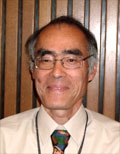Posts Tagged: Gary Nakamura
UCCE forester's retirement to leave a big hole
When UC Cooperative Extension forestry specialist Gary Nakamura retires this summer, he will be "leaving a big hole in our local community," organic farmer Wayne Kessler told the Redding Record-Searchlight.
The article, written by Tim Holt, reviewed Nakamura's nearly 40-year career as a forestry expert, which included stints with private industry and the U.S. Forest Service, before his long-time tenure with UC Cooperative Extension.
Nakamura took on a unique role as a go-between, a soft-spoken and knowledgeable mediator between public and private interests, the article said. In the 1990s, he worked to bring together timber interests, the Forest Service, environmental groups and local communities to form the Shasta Tehama Bioregional Council.
With the council, Nakamura was able to help craft a compromise for understory fuels reduction that:
- Placated environmentalists' concerns with third-party monitoring
- Guaranteed that clearing efforts would be for wildfire suppression and not economic gain
The article said Nakamura is still pursuing collaborative forestry programs. He is now assembling private timber companies, environmental groups, ranchers and public agencies in the Burney Creek/Hat Creek watershed. The effort, involving 340,000 acres of publicly and privately owned lands, will shore up creek banks, restore wetlands, add trails, and "create and maintain a local resource-based economy by encouraging more thinning and biomass harvesting for fuels," Nakamura told the reporter.
"We're fortunate to have highly productive forests in California. My whole career has been about conserving them, and using them wisely," the article quoted Nakamura.
Modifying the lay of the land for fire resistence
Creating defensible space around woodland homes is a legal requirement and common-sense habit. UC Cooperative Extension has developed extensive information that will help homeowners maximize safety while maintaining the greenery that makes rural living desirable, according to an article in the Redding Record Searchlight.
Defensible space, yes, but UC Cooperative Extension forestry advisor Gary Nakamura told reporter Laura Christman, "It doesn't mean you need to nuke the site and clear it."
Bare dirt would be the ultimate in fire defense, but such a landscape comes up short in appearance, erosion control and wildlife habitat. Besides, Nakamura said, many homes that succumb to wildland fire are ignited by embers that drifted a long way from the fire line.
"It's usually not this wall of wildfire coming to the house. That's people's cartoon vision of what happens," Nakamura was quoted.
The strategy of defensible space is to have an area around the house where embers are less likely to ignite plants or structures. Or, if an ember does start a fire, the fire will smolder or burn slowly so it can be extinguished. Homeowners need to create conditions so that firefighters can "safely get in there and fight the fire," Nakamura advised.
The story noted that UC's Home Landscaping for Fire publication recommends thinning brush and trees 70 feet beyond the "lean and green zone," a 30-foot band around the home. Trees shouldn't have limbs any closer than 10 feet from each other and spacing should be farther on hillsides, where fire picks up speed and intensity.
UC has collected research-based information about protecting homes from fire in a wildfire online media kit. The resource contains links to stories, video and UC Web sites dedicated to helping Californians minimize fire damage and stay safe.

One of many UC publications on wildfire resistence.


